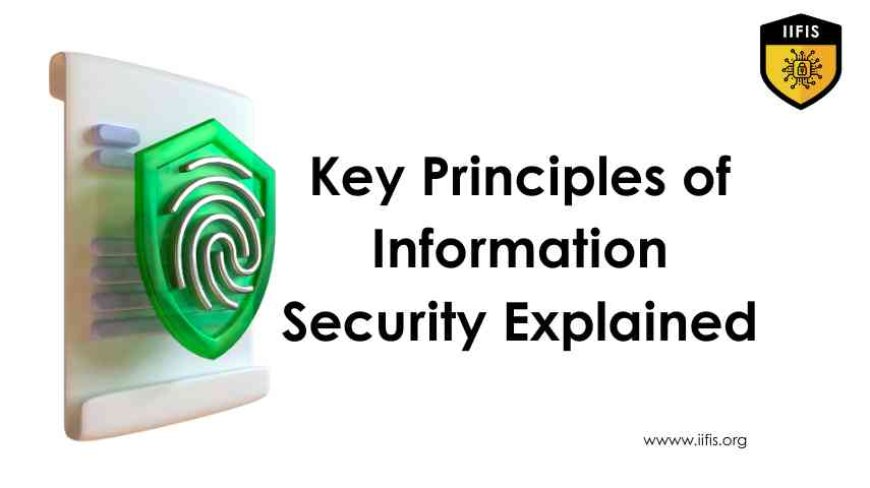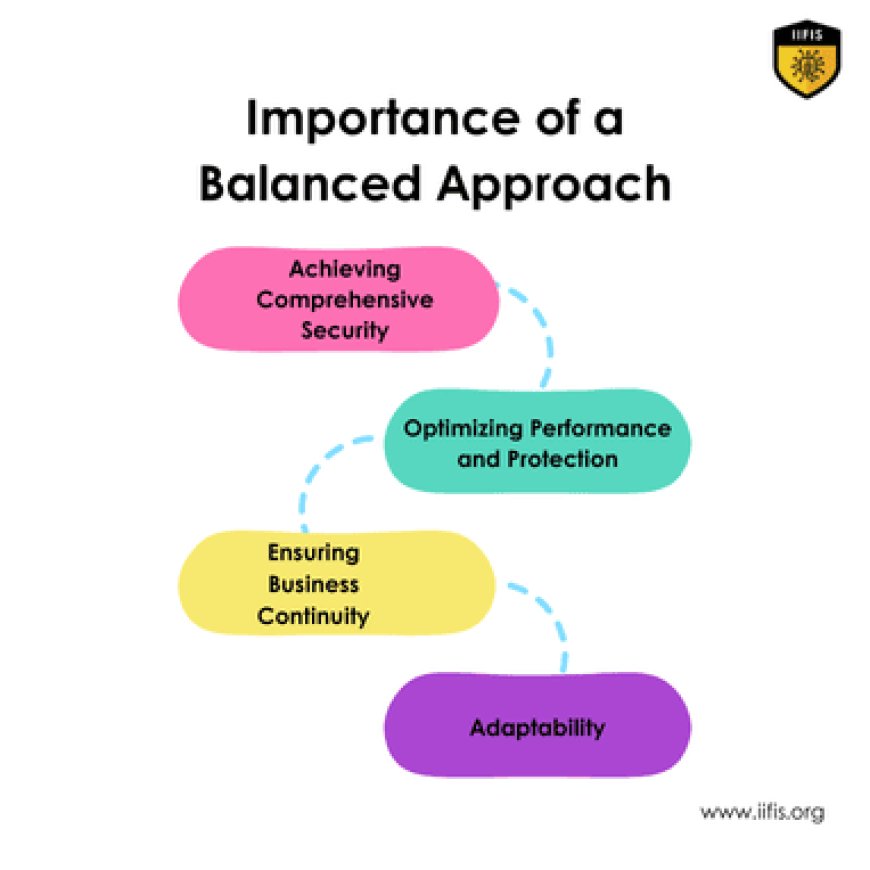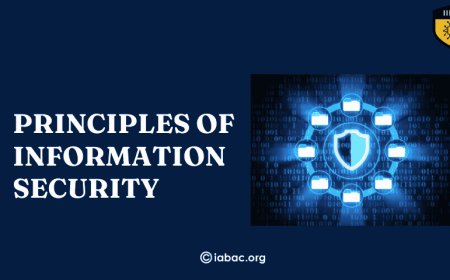Key Principles of Information Security Explained
Discover the key principles of information security and how they protect your data. Learn about confidentiality, integrity, and availability, and their role in safeguarding your information from threats.

Information security is more critical than ever. Protecting sensitive data from unauthorized access,violations, and cyber threats is essential for individuals and organizations alike. Understanding the key principles of information security confidentiality, integrity, and availability helps build a strong foundation for safeguarding information. Look into these core principles, exploring their significance and how they contribute to maintaining a secure and strong information environment.
Information Security refers to the practice of protecting data and information systems from unauthorized access, disruption, modification, or destruction. Its primary goal is to ensure the confidentiality, integrity, and availability of information, whether the data is in storage, in transit, or in use. Information security encompasses a variety of practices, tools, and processes designed to safeguard sensitive information, including personal data, intellectual property, and business information.
This protection is crucial in the digital age, where data is often a valuable asset, and the risk of cyberattacks, data breaches, and other security threats is constantly increasing. Information security measures include encryption, firewalls, access controls, and security policies aimed at preventing unauthorized access, ensuring data accuracy, and keeping systems operational
Importance of Information Security in the Digital Age
Information security is paramount as businesses and individuals are increasingly dependent on digital data and online systems. Protecting sensitive information from unauthorized access, breaches, and cyberattacks is essential to maintaining trust, safeguarding privacy, and ensuring business continuity. With the rise of advanced cyberthreats, implementing strong security measures has become a critical priority for organizations to protect their data and infrastructure.
Overview of the Core Principles of Information Security
-
Confidentiality: Ensures that sensitive data is accessible only to authorized individuals or systems. It involves protecting information from unauthorized access or disclosure, often through encryption, access controls, and secure authentication methods.
-
Integrity: Ensures that data remains accurate, consistent, and unaltered during storage, transmission, or processing. Integrity measures protect against unauthorized modifications or corruption of data through mechanisms like checksums, cryptographic hashing, and regular data backups.
-
Availability: Ensures that information and systems are accessible when needed by authorized users. Availability is maintained by implementing redundancy, disaster recovery plans, and protection against denial-of-service (DoS) attacks to minimize downtime and ensure continuous access to critical resources.
Confidentiality
Definition and Significance
Confidentiality ensures that sensitive information is accessible only to authorized users, protecting privacy and data from unauthorized access. It’s crucial for maintaining trust, compliance, and security.
Common Threats
-
Data Breaches: Unauthorized access to sensitive data.
-
Unauthorized Access: Access by individuals without proper permissions.
-
Phishing Attacks: Deceptive attempts to steal confidential information.
-
Insider Threats: Misuse of access by trusted individuals.
-
Eavesdropping: Interception of data during transmission.
Best Practices
-
Encryption: Protect data at rest and in transit.
-
Access Control: Restrict access based on roles and need-to-know.
-
Multi-Factor Authentication (MFA): Enhance login security with additional verification.
-
Regular Audits: Monitor for unauthorized access and suspicious activities.
-
Data Masking: Hide sensitive data in non-production environments.
-
Security Awareness Training: Educate users on handling sensitive information securely.
Integrity
Explanation of Integrity in Securing Information
Integrity in information security refers to ensuring that data remains accurate, consistent, and unaltered during storage, transmission, or processing. It involves protecting data from unauthorized modifications, corruption, or loss, ensuring that information remains reliable and trustworthy.
Importance of Ensuring Data Accuracy and Consistency
Maintaining data integrity is crucial for reliable decision-making, regulatory compliance, and operational effectiveness. Accurate and consistent data supports effective business processes, prevents errors, and ensures that information used for analysis and reporting is correct.
Strategies for Maintaining Data Integrity
-
Checksums: Use algorithms to generate and verify a unique value for data to detect any changes or corruption.
-
Version Control: Track changes to data or documents, allowing recovery to previous versions and monitoring modifications.
-
Data Validation: Implement rules and procedures to ensure that data entered into systems meets predefined criteria.
-
Access Controls: Restrict data modification permissions to authorized users only, preventing unauthorized changes.
-
Regular Backups: Create backups of data to restore integrity in case of data loss or corruption.
Availability
Understanding Availability in Information Security
Availability in information security ensures that data and systems are accessible to authorized users when needed. It involves maintaining the functionality and uptime of IT systems and services, ensuring they are operational and reliable to support business activities.
Ensuring Timely and Reliable Access to Data
Maintaining availability means users can access data and services without interruption, which is critical for business continuity and operational efficiency. It involves preventing downtime and ensuring that services are consistently available.
Methods to Ensure Availability
-
Redundancy: Implement backup systems and components (e.g., servers, networks) to take over in case of a failure, minimizing downtime.
-
Disaster Recovery Plans: Develop and regularly test plans to restore systems and data after a disaster or major outage.
-
Load Balancing: Distribute traffic and workloads across multiple servers to prevent any single point of failure and improve performance.
-
Regular Maintenance: Perform routine updates and maintenance to prevent system failures and vulnerabilities.
-
High Availability Systems: Use technologies that ensure minimal disruption by automatically switching to backup systems or servers during failures.
Additional Supporting Principles
-
Authentication
Definition: Verifying the identity of users or systems before granting access to data or resources.
Importance: Ensures that only authorized individuals can access sensitive information or perform specific actions.
Methods: Utilize passwords, biometric verification, multi-factor authentication (MFA), and digital certificates to confirm identity. -
Non-repudiation
Definition: Ensuring that once an action is performed, the actor cannot deny their involvement.
Importance: Provides evidence of actions and transactions, preventing users from denying their actions after the fact.
Methods: Use digital signatures, audit logs, and transaction records to create a verifiable trail of actions and communications. -
Accountability
Definition: Holding users responsible for their actions and ensuring they are accountable for their behavior within systems.
Importance: Ensures that users are answerable for their actions, which helps in identifying and addressing misuse or breaches.
Methods: Implement logging and monitoring systems, establish clear policies and procedures, and enforce access controls to track and audit user activities.
Balancing the Principles
Challenges of Maintaining Confidentiality, Integrity, and Availability Simultaneously
-
Conflicting Requirements: Measures to enhance confidentiality, such as strict access controls and encryption, can sometimes impact system performance and accessibility. For example, encrypting data can slow down access times.
-
Resource Constraints: Implementing robust security measures for confidentiality and integrity can be resource-intensive, potentially affecting system availability. Balancing budget and resource allocation while ensuring comprehensive protection can be challenging.
-
Complexity of Integration: Integrating various security measures and technologies to address confidentiality, integrity, and availability can lead to complex systems that are difficult to manage and monitor effectively.
-
Trade-offs: Enhancing one principle may inadvertently impact another. For instance, stringent access controls (confidentiality) might limit user access, affecting availability if not properly managed.
Importance of a Balanced Approach

1.Achieving Comprehensive Security: A balanced approach ensures that all three principles—confidentiality, integrity, and availability—are addressed without compromising any single aspect. This holistic approach helps in creating a robust security posture.
2.Optimizing Performance and Protection: Balancing these principles involves finding the right mix of security controls and performance optimizations to maintain system efficiency while protecting data.
3.Ensuring Business Continuity: A well-balanced security strategy supports business operations by safeguarding data without sacrificing accessibility, thus ensuring that systems remain operational and responsive.
4.Adaptability: A balanced approach allows for flexibility in adapting to changing threats and business needs, ensuring that security measures evolve in alignment with emerging risks and technological advancements.
Real-World Applications of Information Security Principles
Examples of Breaches Due to Failures
-
Confidentiality Breach: Equifax (2017)
-
Issue: Exploited software vulnerability led to the exposure of sensitive data of 147 million people.
-
Failure: Inadequate security measures.
-
Integrity Breach: DNC Hack (2016)
-
Issue: Russian hackers altered and leaked emails, disrupting political processes.
-
Failure: Compromised data integrity.
-
Availability Breach: Dyn DDoS Attack (2016)
-
Issue: Massive DDoS attack caused outages for major websites.
-
Failure: Disrupted service availability.
Implementing Principles to Safeguard Information
-
Confidentiality
-
Encryption: Protect data with encryption.
-
Access Controls: Restrict access using RBAC and MFA.
-
Data Masking: Obscure sensitive data during development.
-
Integrity
-
Checksums: Verify data with checksums and hashes.
-
Version Control: Track and manage changes with version control systems.
-
Regular Audits: Conduct audits to ensure data integrity.
-
Availability
-
Redundancy: Use backup systems and redundancy.
-
Disaster Recovery: Develop and test recovery plans.
-
Load Balancing: Distribute traffic to prevent overload.
The key principles confidentiality, integrity, and availability are essential for protecting data and maintaining trust. Confidentiality ensures that sensitive information remains private and accessible only to authorized users. Integrity guarantees that data remains accurate and unaltered. Availability ensures that data and systems are accessible when needed, without interruption.
Implementing these principles effectively is crucial for robust protection against cyber threats. Businesses must continuously review and update their security measures to adapt to evolving risks and maintain strong defenses. Partnering with organizations like IIFIS (International Institute for Information Security) can provide valuable resources and expertise to enhance your security posture and ensure comprehensive protection.
Stay vigilant, regularly assess your security practices, and keep your systems secure to safeguard your information and maintain operational resilience.
























